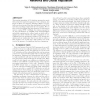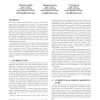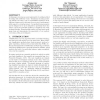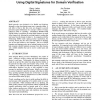130
click to vote
CEAS
2007
Springer
15 years 4 months ago
2007
Springer
Recently, spammers have proliferated "image spam", emails which contain the text of the spam message in a human readable image instead of the message body, making detect...
107
click to vote
CEAS
2007
Springer
15 years 4 months ago
2007
Springer
Active learning methods seek to reduce the number of labeled examples needed to train an effective classifier, and have natural appeal in spam filtering applications where trustwo...
79
Voted
CEAS
2007
Springer
15 years 4 months ago
2007
Springer
Blogs are becoming an increasingly popular target for spammers. The existence of multiple vectors for spam injection, the potential of reaching many eyeballs with a single spam, a...
CEAS
2007
Springer
15 years 6 months ago
2007
Springer
The growing popularity of IP telephony systems has made them attractive targets for spammers. Voice call spam, also known as Spam over Internet Telephony (SPIT), is potentially a ...
105
click to vote
CEAS
2007
Springer
15 years 6 months ago
2007
Springer
The current mail server architecture spawns a new process upon every new connection it receives. The new process deals with the handling of the mail from accepting “Helo” info...
85
Voted
CEAS
2007
Springer
15 years 6 months ago
2007
Springer
We propose a discriminative classifier learning approach to image modeling for spam image identification. We analyze a large number of images extracted from the SpamArchive spam c...
91
Voted
CEAS
2007
Springer
15 years 6 months ago
2007
Springer
Email is a key communication tool for collaborative workgroups. In this paper, we investigate how team leadership roles can be inferred from a collection of email messages exchang...
90
Voted
CEAS
2007
Springer
15 years 6 months ago
2007
Springer
In this paper, we propose a new asymmetric boosting method, Boosting with Different Costs. Traditional boosting methods assume the same cost for misclassified instances from di�...
96
Voted
CEAS
2007
Springer
15 years 6 months ago
2007
Springer
Email protocols were designed to be flexible and forgiving, designed in a day when Internet usage was a cooperative thing. A side effect of that is that they were not designed to ...
CEAS
2007
Springer
15 years 6 months ago
2007
Springer
In contextual computing, where cues beyond direct user input are used to trigger computation, one of the most daunting challenges is inferring what the user is doing. For the doma...




